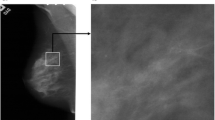Abstract
Lesion segmentation, which is a critical step in computer-aided diagnosis system, is a challenging task as lesion boundaries are usually obscured, irregular, and low contrast. In this paper, an accurate and robust algorithm for the automatic segmentation of breast lesions in mammograms is proposed. The traditional watershed transformation is applied to the smoothed (by the morphological reconstruction) morphological gradient image to obtain the lesion boundary in the belt between the internal and external markers. To automatically determine the internal and external markers, the rough region of the lesion is identified by a template matching and a thresholding method. Then, the internal marker is determined by performing a distance transform and the external marker by morphological dilation. The proposed algorithm is quantitatively compared to the dynamic programming boundary tracing method and the plane fitting and dynamic programming method on a set of 363 lesions (size range, 5–42 mm in diameter; mean, 15 mm), using the area overlap metric (AOM), Hausdorff distance (HD), and average minimum Euclidean distance (AMED). The mean ± SD of the values of AOM, HD, and AMED for our method were respectively 0.72 ± 0.13, 5.69 ± 2.85 mm, and 1.76 ± 1.04 mm, which is a better performance than two other proposed segmentation methods. The results also confirm the potential of the proposed algorithm to allow reliable segmentation and quantification of breast lesion in mammograms.







Similar content being viewed by others
References
Nishikawa RM: Current status and future directions of computer-aided diagnosis in mammography. Comput Med Imaging Graph 31:224–235, 2007
Reddy M, Given-Wilson R: Screening for breast cancer. Women’s Health Medicine 3:22–27, 2006
Dubey RB, Hanmandlu M, Gupta SK: A comparison of two methods for the segmentation of masses in the digital mammograms. Comput Med Imaging Graph 34:185–191, 2010
Morton MJ, Whaley DH, Brandt KR, Amrami KK: Screening mammograms: Interpretation with computer-aided detection—prospective evaluation. Radiology 239:375–383, 2006
Masotti M, Lanconelli N, Campanini R: Computer-aided mass detection in mammography: False positive reduction via gray-scale invariant ranklet texture features. Medical physics 36:311–316, 2009
Eltonsy NH, Tourassi GD, Elmaghraby AS: A concentric morphology model for the detection of masses in mammography. IEEE Trans Med Imaging 26:880–889, 2007
Yuan Y, Giger ML, Li H, Suzuki K, Sennett C: A dual-stage method for lesion segmentation on digital mammograms. Med Phys 34:4180–4193, 2007
Timp S, Karssemeijer N: A new 2D segmentation method based on dynamic programming applied to computer aided detection in mammography. Med Phys 31:958–971, 2004
Rojas DA, Nandi AK: Improved dynamic-programming-based algorithms for segmentation of masses in mammograms. Med Phys 34:4256–4269, 2007
Song E, Jiang L, Jin R, Zhang L, Yuan Y, Li Q: Breast mass segmentation in mammography using plane fitting and dynamic programming. Acad Radiol 16:826–835, 2009
Beucher S, Meyer F: The morphological approach to segmentation: the watershed transformation. Mathematical Morphology in Image Processing, Marcel Dekker Inc 433–481, 1992
Vincent L, Soille P: Watersheds in digital spaces: an efficient algorithm based onimmersion simulations. IEEE transactions on pattern analysis and machine intelligence 13:583–598, 1991
Meyer F, Beucher S: Morphological segmentation. Journal of visual communication and image representation 1:21–46, 1990
Johnson P, Hahn H, Heath D, Fishman E: Automated multidetector row CT dataset segmentation with an interactive watershed transform (IWT) algorithm: Part 2—body CT angiographic and orthopedic applications. J Digit Imaging 21:413–421, 2008
Gomez W, Leija L, Alvarenga AV, Infantosi AFC, Pereira WCA: Computerized lesion segmentation of breast ultrasound based on marker-controlled watershed transformation. Med Phys 37:82–95, 2010
Yan J, Zhao B, Wang L, Zelenetz A, Schwartz LH: Marker-controlled watershed for lymphoma segmentation in sequential CT images. Med Phys 33:2452–2460, 2006
Cui YF, et al: Malignant lesion segmentation in contrast-enhanced breast MR images based on the marker-controlled watershed. Med Phys 36:4359–4369, 2009
Heath M, et al: Current Status of the Digital Database for Screening Mammography. Kluwer Academic, Dordrecht, 1998
Rittner L, de Alencar Lotufo R: Segmentation of DTI based on tensorial morphological gradient. Medical Imaging 2009: Image Processing, Lake Buena Vista, USA, 2009
Vincent L: Morphological grayscale reconstruction in image analysis: Applications and efficient algorithms. IEEE transactions on image processing 2:176–201, 1993
Lin Z, Davis LS, Doermann D, DeMenthon D: Hierarchical part-template matching for human detection and segmentation. Proc. 11th IEEE International Conference on Computer Vision, Rio de Janeiro, 2007
Te Brake GM, Karssemeijer N: Single and multiscale detection of masses in digital mammograms. IEEE Transaction on Medical Imaging 18:628–639, 1999
Morrison S, Linnett LM: A Model Based Approach to Object Detection in Digital Mammography. Kobe, Japan, 1999
Sample JT: Computer Assisted Screening of Digital Mammogram Images. Louisiana State University, Department of Computer Science, Doctor of Philosophy2003
Wang Q, et al: Segmentation of lung nodules in computed tomography images using dynamic programming and multidirection fusion techniques1. Academic Radiology 16:678–688, 2009
Chao WH, Chen YY, Lin SH, Shih YYI, Tsang S: Automatic segmentation of magnetic resonance images using a decision tree with spatial information. Comput Med Imaging Graph 33:111–121, 2009
Zhang J, Wang Y, Shi X: An improved graph cut segmentation method for cervical lymph nodes on sonograms and its relationship with node’s shape assessment. Comput Med Imaging Graph 33:602–607, 2009
Shi J, et al: Characterization of mammographic masses based on level set segmentation with new image features and patient information. Med Phys 35:280–290, 2008
Author information
Authors and Affiliations
Corresponding author
Rights and permissions
About this article
Cite this article
Xu, S., Liu, H. & Song, E. Marker-Controlled Watershed for Lesion Segmentation in Mammograms. J Digit Imaging 24, 754–763 (2011). https://doi.org/10.1007/s10278-011-9365-2
Published:
Issue Date:
DOI: https://doi.org/10.1007/s10278-011-9365-2




